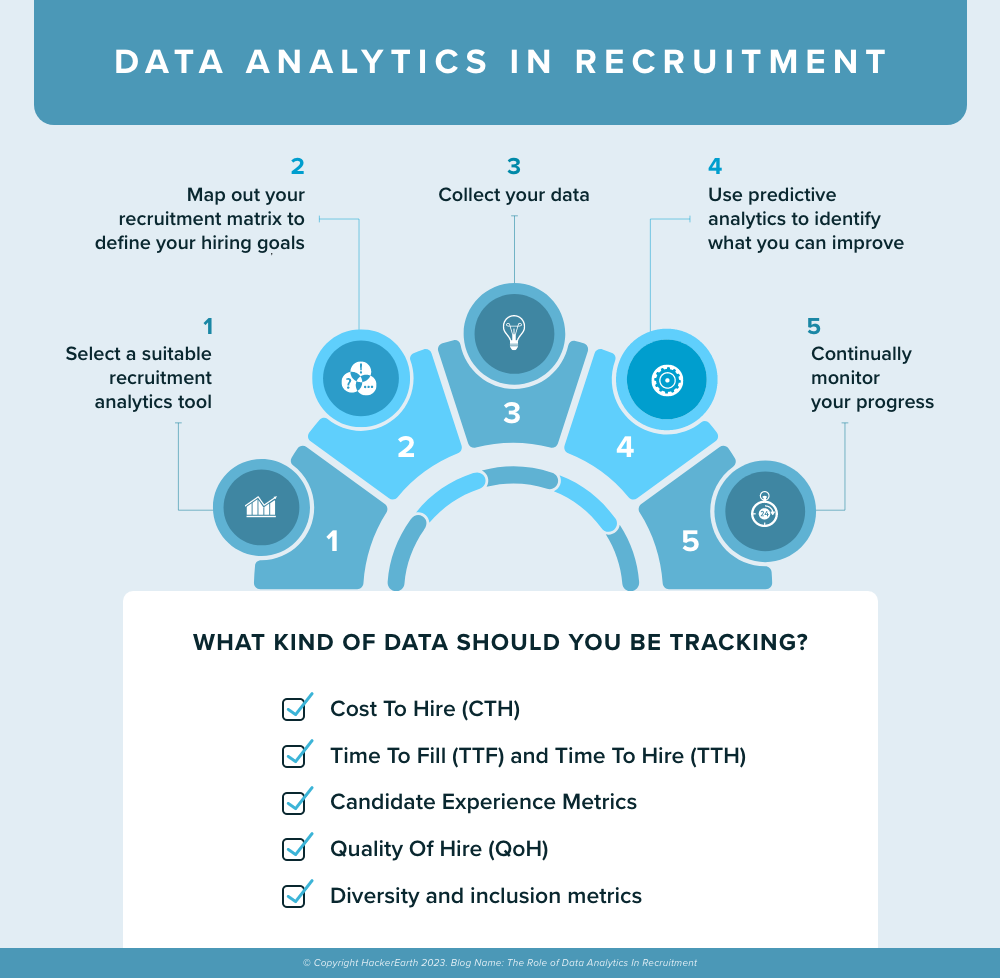Recruitment Analytics
What is Recruitment Analytics?
Definition:
Recruitment analytics refers to the use of data and analytical tools to optimize and streamline the talent acquisition process. It involves collecting, analyzing, and interpreting data related to recruitment and hiring activities to make informed decisions and improve overall hiring effectiveness. By leveraging analytics, organizations can gain valuable insights into their recruitment strategies, identify areas for improvement, and make data-driven decisions to attract and retain top talent.
Analogy:
Consider recruitment analytics as a GPS for talent acquisition. Just as a GPS provides real-time data, alternate routes, and traffic insights to help navigate a journey efficiently, recruitment analytics offers real-time data and insights to guide organizations through the hiring process, ensuring they reach their destination – hiring the right candidates – effectively.
Further Description:
Recruitment analytics encompasses various aspects of the hiring process, including:
Sourcing and Outreach: Analyzing the effectiveness of different recruitment channels, such as job boards, social media, and employee referrals, to identify the most successful sources for attracting qualified candidates.
Candidate Screening: Utilizing data to assess the efficiency of screening processes, including the success rates of various screening methods, to refine and optimize candidate evaluation.
Time-to-Hire: Tracking the time it takes to fill open positions, from posting a job opening to the candidate’s acceptance of an offer, to identify bottlenecks and streamline the hiring timeline.
Cost per Hire: Evaluating the expenses associated with the recruitment process, including advertising costs, recruiter salaries, and technology expenses, to optimize the budget and reduce overall hiring costs.
Quality of Hire: Assessing the performance and retention rates of new hires to measure the success of the recruitment process in bringing in candidates who contribute positively to the organization.
Recruitment analytics can be implemented through the use of advanced technologies like artificial intelligence (AI), machine learning, and predictive analytics to forecast future hiring needs and identify potential talent gaps.
Why is Recruitment Analytics Important?
Efficiency and Effectiveness: By analyzing recruitment data, organizations can identify inefficiencies in the hiring process and implement strategies to make it more effective and streamlined.
Data-Driven Decision Making: Instead of relying on intuition or past practices, recruitment analytics empowers organizations to make informed decisions based on real-time data, leading to more successful hiring outcomes.
Strategic Workforce Planning: Predictive analytics can help organizations anticipate future talent needs, allowing for proactive workforce planning and reducing the likelihood of skill gaps.
Continuous Improvement: Recruitment analytics fosters a culture of continuous improvement by providing insights into what works and what doesn’t, allowing organizations to adapt and refine their recruitment strategies over time.
Examples and Usage:
LinkedIn Talent Insights: This tool provides organizations with data and insights about the talent pool, helping them understand market trends, competitor hiring patterns, and industry-specific talent landscapes.
Greenhouse: Greenhouse is an applicant tracking system (ATS) that incorporates analytics to help organizations measure and improve their hiring processes. It offers features such as interview scorecards, time-to-hire tracking, and candidate pipeline analytics.
Predictive Hiring Platforms: Some platforms use predictive analytics to assess the likelihood of a candidate’s success in a particular role, helping recruiters make more informed decisions about who to interview and hire.
Key Takeaways:
- Recruitment Analytics involves leveraging data to optimize the hiring process and make strategic decisions.
- It encompasses activities such as sourcing optimization, candidate assessment, performance analytics, diversity metrics, and predictive analytics.
- Benefits include efficiency improvement, data-driven decision-making, cost reduction, and improved quality of hires.
- Examples of tools and platforms incorporating recruitment analytics include LinkedIn Talent Insights and predictive hiring tools.
- Incorporating analytics in recruitment is crucial for staying competitive in attracting and retaining top talent in a rapidly evolving job market.
Table of Contents





